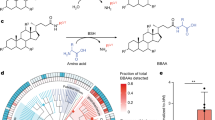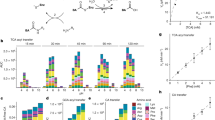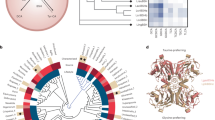Abstract
The gut microbiota synthesize hundreds of molecules, many of which influence host physiology. Among the most abundant metabolites are the secondary bile acids deoxycholic acid (DCA) and lithocholic acid (LCA), which accumulate at concentrations of around 500 μM and are known to block the growth of Clostridium difficile1, promote hepatocellular carcinoma2 and modulate host metabolism via the G-protein-coupled receptor TGR5 (ref. 3). More broadly, DCA, LCA and their derivatives are major components of the recirculating pool of bile acids4; the size and composition of this pool are a target of therapies for primary biliary cholangitis and nonalcoholic steatohepatitis. Nonetheless, despite the clear impact of DCA and LCA on host physiology, an incomplete knowledge of their biosynthetic genes and a lack of genetic tools to enable modification of their native microbial producers limit our ability to modulate secondary bile acid levels in the host. Here we complete the pathway to DCA and LCA by assigning and characterizing enzymes for each of the steps in its reductive arm, revealing a strategy in which the A–B rings of the steroid core are transiently converted into an electron acceptor for two reductive steps carried out by Fe–S flavoenzymes. Using anaerobic in vitro reconstitution, we establish that a set of six enzymes is necessary and sufficient for the eight-step conversion of cholic acid to DCA. We then engineer the pathway into Clostridium sporogenes, conferring production of DCA and LCA on a nonproducing commensal and demonstrating that a microbiome-derived pathway can be expressed and controlled heterologously. These data establish a complete pathway to two central components of the bile acid pool.
This is a preview of subscription content, access via your institution
Access options
Access Nature and 54 other Nature Portfolio journals
Get Nature+, our best-value online-access subscription
$29.99 / 30 days
cancel any time
Subscribe to this journal
Receive 51 print issues and online access
$199.00 per year
only $3.90 per issue
Buy this article
- Purchase on Springer Link
- Instant access to full article PDF
Prices may be subject to local taxes which are calculated during checkout




Similar content being viewed by others
Data availability
Mass spectrometry data that support our findings have been deposited in MassIVE (https://massive.ucsd.edu/ProteoSAFe/static/massive.jsp) under accession code MSV000085048. Source data are provided with this paper.
References
Buffie, C. G. et al. Precision microbiome reconstitution restores bile acid mediated resistance to Clostridium difficile. Nature 517, 205–208 (2015).
Yoshimoto, S. et al. Obesity-induced gut microbial metabolite promotes liver cancer through senescence secretome. Nature 499, 97–101 (2013); corrigendum 506, 396 (2014).
Duboc, H., Taché, Y. & Hofmann, A. F. The bile acid TGR5 membrane receptor: from basic research to clinical application. Dig. Liver Dis. 46, 302–312 (2014).
Arab, J. P., Karpen, S. J., Dawson, P. A., Arrese, M. & Trauner, M. Bile acids and nonalcoholic fatty liver disease: molecular insights and therapeutic perspectives. Hepatology 65, 350–362 (2017).
Nicholson, J. K. et al. Host-gut microbiota metabolic interactions. Science 336, 1262–1267 (2012).
Lee, W.-J. & Hase, K. Gut microbiota-generated metabolites in animal health and disease. Nat. Chem. Biol. 10, 416–424 (2014).
Koppel, N., Maini Rekdal, V. & Balskus, E. P. Chemical transformation of xenobiotics by the human gut microbiota. Science 356, eaag2770 (2017).
Donia, M. S. & Fischbach, M. A. Small molecules from the human microbiota. Science 349, 1254766 (2015).
Patel, K. P., Luo, F. J.-G., Plummer, N. S., Hostetter, T. H. & Meyer, T. W. The production of p-cresol sulfate and indoxyl sulfate in vegetarians versus omnivores. Clin. J. Am. Soc. Nephrol. 7, 982–988 (2012).
Bouatra, S. et al. The human urine metabolome. PLoS ONE 8, e73076 (2013).
Furusawa, Y. et al. Commensal microbe-derived butyrate induces the differentiation of colonic regulatory T cells. Nature 504, 446–450 (2013); erratum 506, 254 (2014).
Maslowski, K. M. et al. Regulation of inflammatory responses by gut microbiota and chemoattractant receptor GPR43. Nature 461, 1282–1286 (2009).
Smith, P. M. et al. The microbial metabolites, short-chain fatty acids, regulate colonic Treg cell homeostasis. Science 341, 569–573 (2013).
Wells, J. E., Berr, F., Thomas, L. A., Dowling, R. H. & Hylemon, P. B. Isolation and characterization of cholic acid 7α-dehydroxylating fecal bacteria from cholesterol gallstone patients. J. Hepatol. 32, 4–10 (2000).
Ridlon, J. M., Kang, D.-J. & Hylemon, P. B. Bile salt biotransformations by human intestinal bacteria. J. Lipid Res. 47, 241–259 (2006).
Hamilton, J. P. et al. Human cecal bile acids: concentration and spectrum. Am. J. Physiol. Gastrointest. Liver Physiol. 293, G256–G263 (2007).
de Aguiar Vallim, T. Q., Tarling, E. J. & Edwards, P. A. Pleiotropic roles of bile acids in metabolism. Cell Metab. 17, 657–669 (2013).
Wahlström, A., Sayin, S. I., Marschall, H.-U. & Bäckhed, F. Intestinal crosstalk between bile acids and microbiota and its impact on host metabolism. Cell Metab. 24, 41–50 (2016).
Brestoff, J. R. & Artis, D. Commensal bacteria at the interface of host metabolism and the immune system. Nat. Immunol. 14, 676–684 (2013).
White, B. A., Lipsky, R. L., Fricke, R. J. & Hylemon, P. B. Bile acid induction specificity of 7α-dehydroxylase activity in an intestinal Eubacterium species. Steroids 35, 103–109 (1980).
Ridlon, J. M., Harris, S. C., Bhowmik, S., Kang, D.-J. & Hylemon, P. B. Consequences of bile salt biotransformations by intestinal bacteria. Gut Microbes 7, 22–39 (2016).
Mallonee, D. H., Lijewski, M. A. & Hylemon, P. B. Expression in Escherichia coli and characterization of a bile acid-inducible 3α-hydroxysteroid dehydrogenase from Eubacterium sp. strain VPI 12708. Curr. Microbiol. 30, 259–263 (1995).
Mallonee, D. H., Adams, J. L. & Hylemon, P. B. The bile acid-inducible baiB gene from Eubacterium sp. strain VPI 12708 encodes a bile acid-coenzyme A ligase. J. Bacteriol. 174, 2065–2071 (1992).
Bhowmik, S. et al. Structural and functional characterization of BaiA, an enzyme involved in secondary bile acid synthesis in human gut microbe. Proteins 82, 216–229 (2014).
Kang, D.-J., Ridlon, J. M., Moore, D. R., II, Barnes, S. & Hylemon, P. B. Clostridium scindens baiCD and baiH genes encode stereo-specific 7α/7β-hydroxy-3-oxo-Δ4-cholenoic acid oxidoreductases. Biochim. Biophys. Acta 1781, 16–25 (2008).
Dawson, J. A., Mallonee, D. H., Björkhem, I. & Hylemon, P. B. Expression and characterization of a C24 bile acid 7 alpha-dehydratase from Eubacterium sp. strain VPI 12708 in Escherichia coli. J. Lipid Res. 37, 1258–1267 (1996).
Ye, H. Q., Mallonee, D. H., Wells, J. E., Björkhem, I. & Hylemon, P. B. The bile acid-inducible baiF gene from Eubacterium sp. strain VPI 12708 encodes a bile acid-coenzyme A hydrolase. J. Lipid Res. 40, 17–23 (1999).
Harris, S. C. et al. Identification of a gene encoding a flavoprotein involved in bile acid metabolism by the human gut bacterium Clostridium scindens ATCC 35704. Biochim. Biophys. Acta Mol. Cell Biol. Lipids 1863, 276–283 (2018).
González-Pajuelo, M. et al. Metabolic engineering of Clostridium acetobutylicum for the industrial production of 1,3-propanediol from glycerol. Metab. Eng. 7, 329–336 (2005).
Higashide, W., Li, Y., Yang, Y. & Liao, J. C. Metabolic engineering of Clostridium cellulolyticum for production of isobutanol from cellulose. Appl. Environ. Microbiol. 77, 2727–2733 (2011).
Kovács, K. et al. Secretion and assembly of functional mini-cellulosomes from synthetic chromosomal operons in Clostridium acetobutylicum ATCC 824. Biotechnol. Biofuels 6, 117 (2013).
Mingardon, F., Chanal, A., Tardif, C. & Fierobe, H.-P. The issue of secretion in heterologous expression of Clostridium cellulolyticum cellulase-encoding genes in Clostridium acetobutylicum ATCC 824. Appl. Environ. Microbiol. 77, 2831–2838 (2011).
Heap, J. T., Pennington, O. J., Cartman, S. T. & Minton, N. P. A modular system for Clostridium shuttle plasmids. J. Microbiol. Methods 78, 79–85 (2009).
Wang, Y. et al. Bacterial genome editing with CRISPR–Cas9: deletion, integration, single nucleotide modification, and desirable “clean” mutant selection in Clostridium beijerinckii as an example. ACS Synth. Biol. 5, 721–732 (2016).
Hang, S. et al. Bile acid metabolites control TH17 and Treg cell differentiation. Nature 576, 143–148 (2019).
Sheridan, P. O. et al. Heterologous gene expression in the human gut bacteria Eubacterium rectale and Roseburia inulinivorans by means of conjugative plasmids. Anaerobe 59, 131–140 (2019).
Hao, T. et al. An anaerobic bacterium host system for heterologous expression of natural product biosynthetic gene clusters. Nat. Commun. 10, 3665 (2019).
Huo, L. et al. Heterologous expression of bacterial natural product biosynthetic pathways. Nat. Prod. Rep. 36, 1412–1436 (2019).
Keasling, J. D. Manufacturing molecules through metabolic engineering. Science 330, 1355–1358 (2010).
Pickens, L. B., Tang, Y. & Chooi, Y.-H. Metabolic engineering for the production of natural products. Annu. Rev. Chem. Biomol. Eng. 2, 211–236 (2011).
Leppik, R. A. Improved synthesis of 3-keto, 4-ene-3-keto, and 4,6-diene-3-keto bile acids. Steroids 41, 475–484 (1983).
Lanz, N. D. RlmN and AtsB as models for the overproduction and characterization of radical SAM proteins. Methods Enzymol. 516, 125–152 (2012).
Acknowledgements
We thank C. T. Walsh, D. Dodd, C. O’Loughlin and members of the Fischbach and Almo laboratories for helpful comments on the manuscript. This work was supported by National Institutes of Health (NIH) grants DP1 DK113598 (to M.A.F.), R01 DK110174 (to M.A.F.), P01 HL147823 (to M.A.F.), P01 GM118303-01 (to S.C.A.), U54 GM093342 (to S.C.A.), U54 GM094662 (to S.C.A.) and DP2 HD101401-01 (to C.G.); the Chan–Zuckerberg Biohub (to M.A.F.); a Howard Hughes Medical Institute (HHMI)–Simons Faculty Scholars Award (to M.A.F.); an Investigators in the Pathogenesis of Infectious Disease Award from the Burroughs Wellcome Foundation (to M.A.F.); and the Price Family Foundation (to S.C.A.).
Author information
Authors and Affiliations
Contributions
M.F., T.L.G., S.C.A. and M.A.F. conceived and designed the experiments. M.F. developed the system for gene-cluster expression in Clostridium, and M.F., C.G. and Y.V. performed the bacterial genetics experiments. T.L.G. expressed and purified enzymes and set up biochemical reconstitution experiments. M.F. analysed the data from biochemical and microbiological experiments by LC–MS. M.E.M. and L.C.B. synthesized bile acid intermediates. M.W. and S.H. performed and analysed mouse experiments. M.F., T.L.G., M.W., S.C.A. and M.A.F. analysed data and wrote the manuscript. All authors discussed the results and commented on the manuscript.
Corresponding authors
Ethics declarations
Competing interests
M.A.F. is a co-founder and director of Federation Bio.
Additional information
Peer review information Nature thanks Pieter Dorrestein and the other, anonymous, reviewer(s) for their contribution to the peer review of this work.
Publisher’s note Springer Nature remains neutral with regard to jurisdictional claims in published maps and institutional affiliations.
Extended data figures and tables
Extended Data Fig. 1 Previously proposed pathway for 7α-dehydroxylation of cholic acid in C. scindens VPI 12708.
See main text for details and a summary of the previous literature. CA, cholic acid.
Extended Data Fig. 2 Purification of recombinant Bai proteins.
a, SDS–PAGE analysis of purified Bai proteins after Ni-affinity and size-exclusion purification, visualized by Coomassie blue staining. The image was generated using a Bio-Rad Gel Doc Universal Hood II Molecular Imager. MWM, molecular weight marker; 1, BaiB from C. scindens; 2, BaiB from C. hylemonae; 3, BaiCD from C. hiranonis; 4, BaiE from C. scindens; 5, BaiE from C. hiranonis; 6, BaiA2 from C. scindens; 7, BaiF from C. hylemonae; 8, BaiH from C. scindens; 9, BaiI from C. scindens; 10, BaiI from C. hiranonis.b, Ultraviolet–visible spectra of BaiCD from C. hiranonis (24 μM, left) and BaiH from C. scindens (13 μM, right). Features at 370 nm and 450 nm are indicative of flavin bound to BaiCD and BaiH, and are partially obscured by the presence of a [4Fe–4S] cluster, which has broad absorbance between 300 nm and 700 nm. c, The presence of FMN and FAD is confirmed by mass spectrometry. Experiments in a–c were repeated independent twice, with similar results.
Extended Data Fig. 3 Bile acid standards.
a, For each compound in the study for which we have an authentic standard, we show an EIC of the authentic standard and the experimentally observed compound. Because the data shown here were collected from samples run at different times, a drift in retention time may be responsible for the peak pairs that do not have identical retention times. b, We observed a drift in retention time in the LC–MS data collected for the experiment shown in Fig. 2c. For two representative compounds from that data set, we show an EIC of the experimentally observed compound and an authentic standard run contemporaneously, showing that the retention times remain consistent with our peak assignments.
Extended Data Fig. 4 Kinetic parameters for BaiCD and BaiH.
a, Michaelis–Menten analysis of the conversion of 3-oxo-4,5-dehydro-DCA to 3-oxo-DCA by BaiCD. Reaction mixtures contained 0.45 μM BaiCD and 1 mM NADH, with the substrate concentration varying between 15 μM and 500 μM. b, Michaelis–Menten analysis of the conversion of 3-oxo-4,5,6,7-didehydro-DCA to 3-oxo-4,5-dehydro-DCA by BaiH. Reaction mixtures contained 0.45 μM BaiH and 1 mM NADH, with the substrate concentration varying between 3 μM and 100 μM. Data indicate the average product level ± 1 s.d. (three biological replicates).
Extended Data Fig. 5 Biochemical analysis of 3-oxo-DCA reduction by BaiA2.
Combined EICs showing the conversion of 3-oxo-DCA to DCA by recombinant BaiA2. This experiment was performed once.
Extended Data Fig. 6 7α-dehydroxylation of CDCA in vivo.
Combined EICs showing the conversion of CDCA to LCA by a C. sporogenes strain harbouring the complete bai operon on three plasmids (MF001) versus a control strain of C. sporogenes harbouring the transporter baiG (MF012). The strains were cultivated with 1 μM cholic acid for 72 h; an acetone extract of the culture supernatant was analysed by high-performance LC (HPLC)/MS. The single asterisk indicates isoLCA; the peak indicated by the double asterisk is provisionally assigned as isoCDCA. This experiment was performed once.
Extended Data Fig. 7 Constructs for expressing the bai operon and portions thereof in C. sporogenes.
Each of the plasmids has replication origins (origin and repH) for E. coli and Clostridium, the traJ gene to enable conjugal plasmid transfer, and an antibiotic-resistance gene (catP, aad9 or ermB). The bai genes were introduced into these plasmids under the control of the fdx or spoIIE promoter. For the genetic analysis of baiCD and baiH function, pMTL83153-based plasmids were used.
Extended Data Fig. 8 Metabolic logic of the 7α-dehydroxylation pathway.
Highly oxidized metabolic intermediates as anaerobic electron acceptors. In the first half of the 7α-dehydroxylation pathway, two successive two-electron oxidations set up a vinylogous dehydration of the 7-hydroxyl, yielding the highly oxidized intermediate 3-oxo-4,5-6,7-didehydro-DCA. In the second half of the pathway, three successive two-electron reductions reduce this molecule to DCA, resulting in a net two-electron reduction. The first two of these reductions are carried out by Fe–S flavoenzymes, which comprise a suite of four cofactors that enable them to convert two-electron inputs to a one-electron manifold. The previously proposed pathway is shown in Extended Data Fig. 1.
Supplementary information
Supplementary Information
This file contains the Supplementary Discussion and Supplementary References.
Supplementary Table 1
Data supporting our provisional chemical structure assignments.
Supplementary Table 2
Plasmids used in this study.
Supplementary Table 3
Bacterial strains used in this study.
Supplementary Table 4
Primers used for heterologous expression in C. sporogenes.
Supplementary Table 5
Primers used for expression of Bai proteins in E. coli.
Source data
Rights and permissions
About this article
Cite this article
Funabashi, M., Grove, T.L., Wang, M. et al. A metabolic pathway for bile acid dehydroxylation by the gut microbiome. Nature 582, 566–570 (2020). https://doi.org/10.1038/s41586-020-2396-4
Received:
Accepted:
Published:
Issue Date:
DOI: https://doi.org/10.1038/s41586-020-2396-4
This article is cited by
-
The gut-liver axis in hepatobiliary diseases
Inflammation and Regeneration (2024)
-
Interindividual differences in aronia juice tolerability linked to gut microbiome and metabolome changes—secondary analysis of a randomized placebo-controlled parallel intervention trial
Microbiome (2024)
-
Another renaissance for bile acid gastrointestinal microbiology
Nature Reviews Gastroenterology & Hepatology (2024)
-
Evolutionarily related host and microbial pathways regulate fat desaturation in C. elegans
Nature Communications (2024)
-
Integrated annotation prioritizes metabolites with bioactivity in inflammatory bowel disease
Molecular Systems Biology (2024)
Comments
By submitting a comment you agree to abide by our Terms and Community Guidelines. If you find something abusive or that does not comply with our terms or guidelines please flag it as inappropriate.



